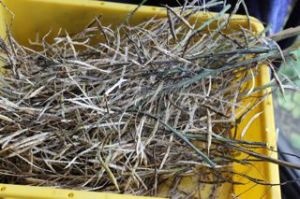Microgreens from your own saved seed
It is a great idea to let your vegetable plants go to seed and then harvest the seed for the next crop. That way you are breeding your own vegetables that are adapted to your area, your soil and your growing conditions or climate. It also saves you money as seeds are becoming expensive to buy.
In this article I am describing how I harvest kale seed and then grow microgreens from the saved seeds.
In the photo to the left are the stalks I harvested from one curly kale plant. I left them on the plant until they were totally brown, brittle and dry. It is a trick to catch them before the seed-heads split open and release the seed as then you can’t collect them as they will have fallen to the soil. However, that way you’ll get self sown kale which makes for healthy plants (healthy because they are growing where they landed and if left undisturbed make strong roots) . However, you can move them if they are in the wrong place. It is good to have a large collecting container as the next step is to rub the stalks together in your hands to break open the seed-heads (two long cases either side of the stalk which contain two rows of seeds) and release the seeds which can jump out of a small container. Once you have rubbed all the seed-heads open and released the small, black, round seeds you can remove the hard wooden stalks.
Then you’re just left with seed cases and seeds as in the photo to the right. Next you tip up the container to gather all the material in one corner. The seeds are heavier than the light cases and will be on top. You just collect up the cases and remove. You’ll get quite a pile. You keep doing that until you’ve removed as much as you can that is not seed. I then put the cases along with the wooden stalks on the compost heap as they all being brown add good carbon to the compost.
I am always amazed how much seed just one plant produces. This plant yielded over half a cup full.
Now you can use the harvested seed to grow microgreens which provide fresh greens for your salads (photo below).
I use an old steamer pan with holes in the bottom as the container. The handle is great for moving it to different locations. I fill it with good potting mix, mix in some of our compost and sow the seed pretty thickly. The seeds are not touching but quite close. The seeds germinate in ten days or so depending on the season and temperature and if you leave them to grow several centimeters they can be harvested, snipped off with scissors and put straight into a fresh salad, providing vitamins, antioxidants, chlorophyll, enzymes, and a nice crunch.
A little known fact is that vitamins need to be eaten within half an hour for maximum benefit. So if you grow your own micro-greens and eating them straight away you get the highest possible nutrition. How cool is that!







